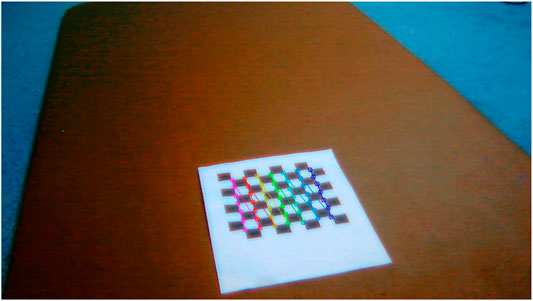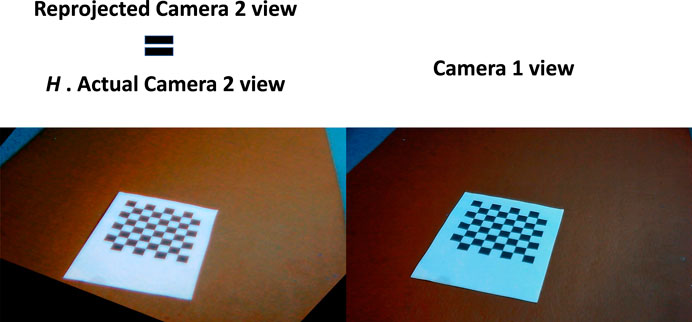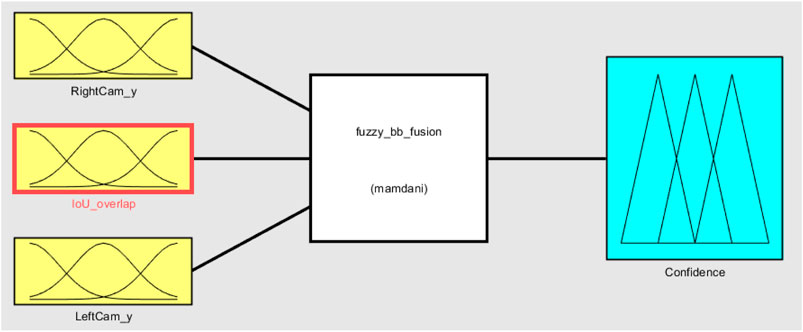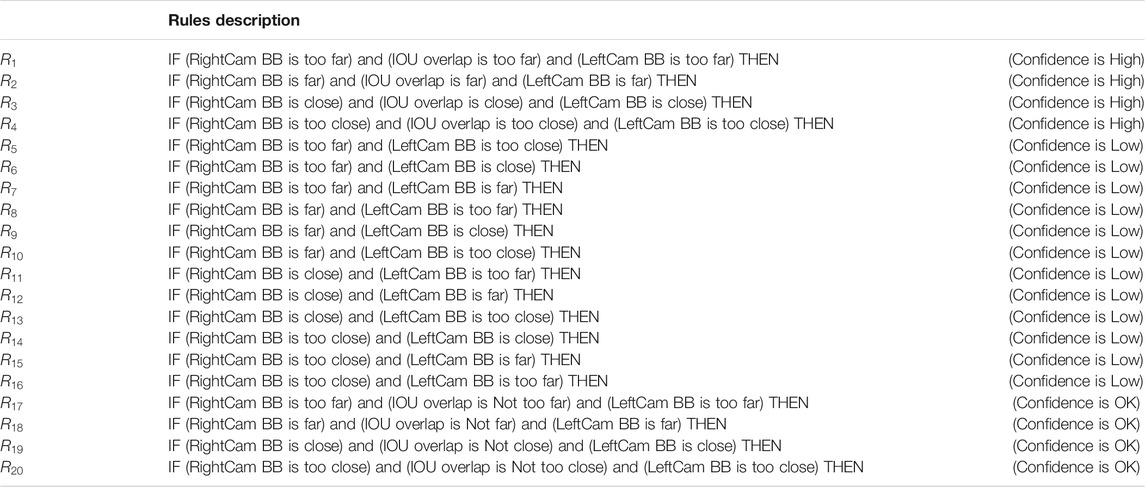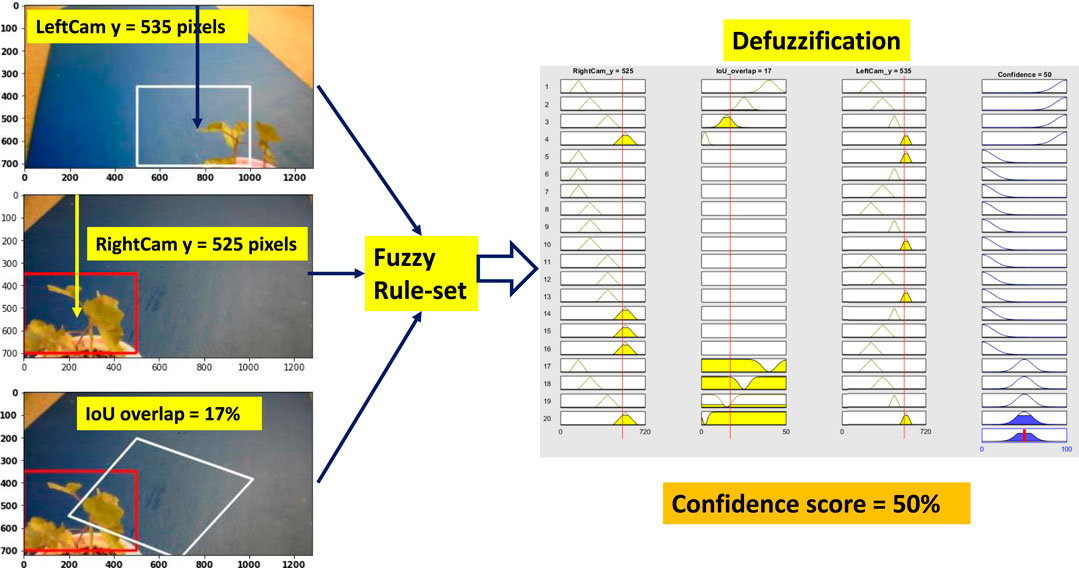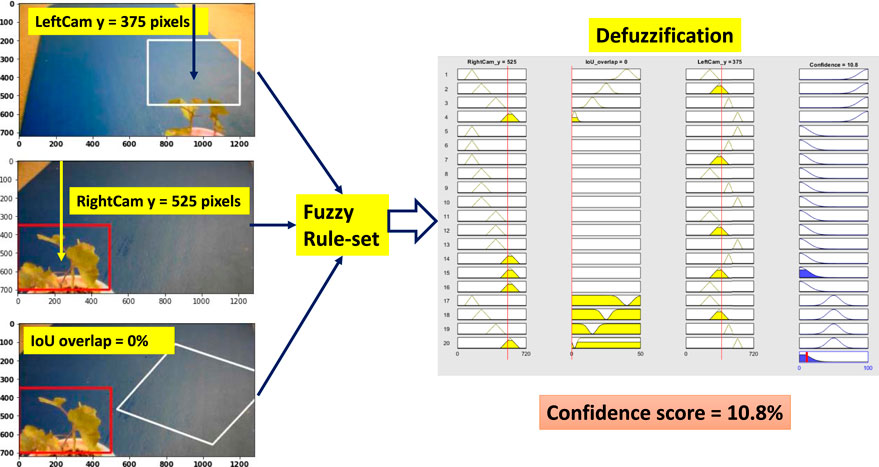- 1Department of Mechanical and Energy Engineering, Indiana University Purdue University Indianapolis, Indianapolis, IN, United States
- 2Department of Computer and Information Science, Indiana University Purdue University Indianapolis, Indianapolis, IN, United States
A single camera creates a bounding box (BB) for the detected object with certain accuracy through a convolutional neural network (CNN). However, a single RGB camera may not be able to capture the actual object within the BB even if the CNN detector accuracy is high for the object. In this research, we present a solution to this limitation through the usage of multiple cameras, projective transformation, and a fuzzy logic–based fusion. The proposed algorithm generates a “confidence score” for each frame to check the trustworthiness of the BB generated by the CNN detector. As a first step toward this solution, we created a two-camera setup to detect objects. Agricultural weed is used as objects to be detected. A CNN detector generates BB for each camera when weed is present. Then a projective transformation is used to project one camera’s image plane to another camera’s image plane. The intersect over union (IOU) overlap of the BB is computed when objects are detected correctly. Four different scenarios are generated based on how far the object is from the multi-camera setup, and IOU overlap is calculated for each scenario (ground truth). When objects are detected correctly and bounding boxes are at correct distance, the IOU overlap value should be close to the ground truth IOU overlap value. On the other hand, the IOU overlap value should differ if BBs are at incorrect positions. Mamdani fuzzy rules are generated using this reasoning, and three different confidence scores (“high,” “ok,” and “low”) are given to each frame based on accuracy and position of BBs. The proposed algorithm was then tested under different conditions to check its validity. The confidence score of the proposed fuzzy system for three different scenarios supports the hypothesis that the multi-camera–based fusion algorithm improved the overall robustness of the detection system.
1 Introduction
Real-time weed detection is an emerging field where agricultural robots apply deep neural networks for real-time weed detection, crop management, and path planning extensively (Vougioukas, 2019; Wang et al., 2019). With the emergence of agricultural robotics, accurate identification of weeds and crops with deeper understanding of overall object detection technology becomes more important. In general, object detection systems detect a target object using classical computer vision and deep learning techniques, determine the category of the detected object, and create a bounding box marking the position of the object (Russakovsky et al., 2015; Zhiqiang and Jun, 2017). But real-time object detection is a complex challenge due to the effect of background, noise, occlusion, resolution, and scale affecting the performance of the system (Zhiqiang and Jun, 2017). In 2013, R-CNN (regions with CNN features) (Girshick et al., 2014) showed much improvement in object detection compared to conventional computer vision techniques and started the trend on CNN-based object detection.
Many state-of-the-art convolutional neural network (CNN) detector models like SPP-net (He et al., 2015), Fast R-CNN (Girshick et al., 2014), YOLO (Redmon et al., 2016), and RetinaNet (Lin et al., 2017) improved detection accuracy on standard image datasets using new CNN architectures. But in most of the cases, CNN models are trained with images without noise or degradation. During training, image augmentation is used to introduce noise to increase the robustness of the model, but sometimes, they may fail to capture the real scenario. It is not possible to include all probable types of noise during the training of a CNN. In the real scenario, noise can affect the quality of image due to sensor quality, lighting, vibration, exposure time, etc. It is already shown that introducing carefully selected noise can produce wrong results even though they have no effect on visual recognition (Moosavi-Dezfooli et al., 2016). Prasun et al. (Roy et al., 2018) showed how different image degradations can affect the performance of CNN models. They were unable to come up with a solution which can produce a robust CNN architecture against image degradation when a large number of classes are present, such as ImageNet. Moreover, in recent times, it is observed that the accuracy of CNNs reduces significantly when only tested on negative images, which shows an inherent bias toward positive training dataset (Hosseini et al., 2017). In this research, we want to address this inherent limitation of CNN regarding uncertainty toward correct object detection and bounding box (BB) creation with a multi-camera setup and fuzzy logic.
Fuzzy logic has high potential in understanding complex systems where analytical solution may not exist or the system is not understood properly but can be observed (Ross et al., 2004). According to Ross, fuzzy systems are useful in two scenarios: “1) in situations involving highly complex systems whose behaviors are not well understood and 2) in situations where an approximate, but fast, solution is warranted” (Ross et al., 2004). In agricultural robotics, fuzzy neural network–based sliding mode control is used to build an apple picking robot (Chen et al., 2019). Romeo et al. used fuzzy clustering with dynamic threshold for greenness identification (Romeo et al., 2013). Meyer et al. used fuzzy clustering for classifying plant and soil from color images (Meyer et al., 2004). A fuzzy classifier is used to detect weeds in real time in sugarcane fields (Sujaritha et al., 2017). A fuzzy expert system is used in soil management (López et al., 2008), to predict cotton yield (Papageorgiou et al., 2011), and in crop disease management with a text-to-talk user interface (Kolhe et al., 2011). In general, fuzzy logic is used as a classifier for crop or weed detection and as an expert system for crop, weed, and soil management. But no thorough research studies are found which used fuzzy logic to improve weed detection accuracy using a multi-camera setup.
The goal of this research was to implement a multi-sensor–based fuzzy fusion algorithm to improve the robustness of any CNN-based object detection system. In this article, Section 2 presents the research steps. Section 3 shows the experimental setup of the multi-camera system. It also shows how the homography matrix is calculated for this setup. Section 4 describes the CNN-based object detection method with classification results. Section 5 describes the fuzzy rules and membership functions. Section 6 shows the results of the fuzzy fusion system.
2 Methodology
Weed can be detected with a CNN-based detector with very high accuracy and in real time. If we use multiple cameras, then the robustness of the overall system increases. When we use a detector to create a BB, it gives us the accuracy percentage of objects inside the BB and the position of the BB. In this article, we explore the possibility of improving the overall system robustness by measuring the “confidence” of the BB position of multiple cameras. The detector will give us the position of BB on each image plane. But how do we know for sure that the position of the BB is correct? When we are detecting an object using multiple cameras, the position of the BB on the camera image plane may appear in different places based on the detection accuracy and the position of the cameras. But in 3D space, the object is at the exact same position for both cameras. We will manipulate this information to calculate the confidence score of the BB position using projective transformation, IoU overlap value, and fuzzy logic–based fusion. We will complete the following steps to calculate the confidence score:
• Create a two-camera setup and calculate the homography between the two cameras.
• Place weed (object) at different specific distances from the camera setup.
• Use a CNN detector to create BB of detected weed on both cameras. Use best possible detection BB so that the weed is perfectly detected and inside the BB.
• Use the homography matrix to project one camera image plane over another, and then calculate the IoU overlap values of the BBs after projection for different weed positions.
• The logic is as follows: if perfect BB is created at a certain distance of weed position, then it will have a specific IOU overlap value. We will have “high” confidence for this scenario. If the position or IOU value deviates from the perfect condition, then we will have “less than high” confidence on the detection. Use fuzzy “IF...THEN” rules to capture these conditions.
• Use defuzzification to get the crisp “confidence” value for different scenarios.
3 Projective Transformation
In a pinhole camera model, a point in 3D space is projected onto an imaging surface which is called an image plane (Kaehler and Bradski, 2016). All rays (or points) of light pass through a single point which is called a camera center. The size of the object on the image plane can be calculated from a similar triangle. Assuming the camera is calibrated or there are no distortions (radial and barrel distortion), a point
where f is the focal length.
The relationship that maps a set of points from one image plane to a set of points to another image plane is called projective transformation. Planar homography is the projective mapping from one plane to another. According to Hartley and Zisserman (Hartley and Zisserman, 2003), projective transformation is defined as “A planar projective transformation is a linear transformation on homogeneous 3-vectors represented by a non-singular 3-by-3 matrix.”
Or in short,
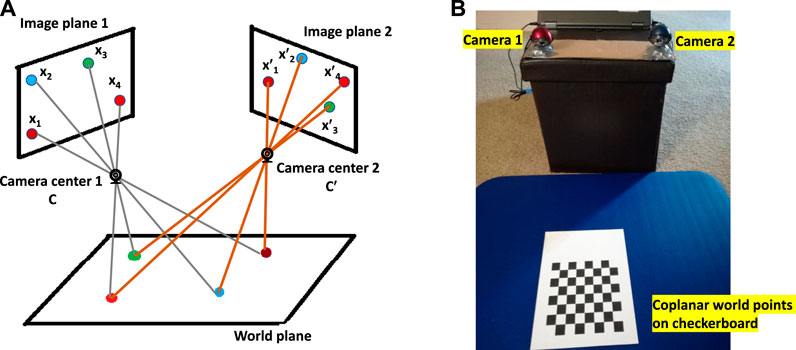
FIGURE 1. (A) For multiple cameras, image planes are related by projective transformation when all world points are coplanar. (B) Actual setup of two cameras with coplanar checkerboard points.
Let us consider a pair of inhomogeneous matching points
After rearranging:
Four points on each image plane will create eight linear equations, and these four points are sufficient to solve for H between two image planes. If only four points are used, then the only condition is no three points can be colinear (Hartley and Zisserman, 2003). If more than four points are used, then no
Important remarks:
1. Camera intrinsic parameters or pose are not needed to calculate H.
2. If only four points are used to calculate H, then outliers can create the incorrect H matrix.
3. Including more points and using a robust method to minimize a reprojection error will help to calculate the correct H matrix.
3.1 Homography Matrix Calculation
We have established that no camera or pose parameters are needed to calculate the homography matrix, H. As a result, the following steps are followed to calculate H:
1. Place a printed checkerboard pattern in front of the cameras (Figure 1B).
2. Measure the pixel locations of checkerboard corners for each camera (Figure 2 and Figure 3).
3. Calculate the reprojection error which is the sum of squared Euclidean distances between H times the camera 2 checkerboard corner points and camera 1 checkerboard corner points.
4. Use an optimization algorithm to minimize the reprojection error for a specific H matrix.
We have tested four different optimization algorithms for H matrix calculation. The goal is to find a H matrix that minimizes the reprojection error. Least mean square minimizes the mean squared distance between checkerboard’s corner points of the two image planes. RANSAC is an iterative method, and it tries to find the correct corner points and eliminates the outlier corner points. PROSAC is a weighted RANSAC method, which is faster in case of many outliers. Least median square minimizes the squared median distances and more robust than least mean square when outlier is present. Then we calculated the projection error between the actual checkerboard corner locations and projected checkerboard corner locations. The error is calculated in terms of how much each corner point deviates from the actual corner location in terms of pixels. All results are presented in Table 1. Once the H matrix is calculated, that will remain the same as long as camera positions are constant. As Table 1 shows, both least mean square and least median square resulted in minimum reprojection errors. The H matrix calculated is
Figure 4 shows how the H matrix is used to reproject camera 2 view into camera 1 view. The left image of Figure 4 is the actual left camera view (Figure 2) multiplied by H which projects the left camera view into the right camera view.
4 CNN-Based Weed Detection
For this study, we considered a VGG16-based (Simonyan and Zisserman, 2014) model architecture with transfer learning. This model is retrained using a small weed dataset, and final layers are rearranged to classify three different weeds. Transfer learning retrains the final layers of the VGG16 model to classify new objects from a new dataset by using the large amount of features already learned from the ImageNet database. Previous research (Karpathy et al., 2014; Mohanty et al., 2016) has shown that transfer learning has much lower computational requirements than learning from scratch and can be applied to various types of classification. All the training simulations are run on an Intel core-i7, 8gb ram, Nvidia GTX 1060 6gb workstation. Models are built with Keras library on TensorFlow backend in Python 3.5.
Images of common cocklebur, redroot pigweed, and giant ragweed are captured to generate a weed dataset. These three types of commonly found corn weeds were grown in the IUPUI Greenhouse in order to collect images. Also, images were captured from actual corn fields. Maximum input image size used in this study is 150-by-150 pixels (input dimension of the CNN network).
4.1 Transfer Learning With VGG16
VGG16 is a 16-layer CNN which introduced the idea of multiple small kernel filters. Trained on the ImageNet dataset from 2012, it was able to classify 1,000 classes. The top-5 error rate of VGG16 was 7.4% (Simonyan and Zisserman, 2014). The model parameters implemented in this study include learning rate (1e-05), optimizer (Adam), and loss (sparse categorical cross-entropy).
Now, we fit a detector on top of the classifier to get the BB. We should mention that we are just fitting a detector, and we are not training the detector for better performance. First, an image pyramid is created to deal with different scale factors. The reason is to detect objects at different scales. As the image pyramid grows bigger, it will help to detect bigger objects. Then we run a sliding window at each scale of the pyramid. The size of the sliding window should depend on the size of the object to be detected. At each position of the sliding window, we are passing it through the CNN classifier and saving the class label with
From classification report in Table 2, we can say that Cocklebur shows near-perfect recall. Pigweed is the hardest one to classify as the CNN model shows only 0.89 recall. Inference time is an important parameter for real-time classification from the video feed. This inference time (without GPU acceleration) seems adequate (about four frames per second (FPS)) for our test case. With GPU acceleration (Nvidia GTX 1060 Ti), this model performs at around 30 FPS.
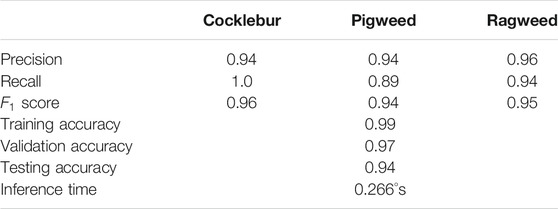
TABLE 2. Classification report of the trained CNN model. Inference time tested on a Core-i5, 8 gb ram machine.
4.2 IOU Overlap Calculation
Now that we have the BB from the detector, we want to calculate the IOU value for left and right camera BBs. We want to see how the IOU value changes before and after reprojection when weed is detected correctly and the BB is created. We also want to see how the IOU value changes when weed is detected at different distances from the camera.
Figure 5 shows how BBs from both cameras overlap each other at different distances. “Too far” is about 36 inches away from the camera, and “too close” is about 8 inches away from the camera. BB sizes are fixed for both the cameras. We also assume perfect detection. As the weed moves closer to the camera, we can see that the BB overlap is decreasing, and for the “Too close” position, without reprojection, the BB overlap is zero. With reprojection (the left camera image is reprojected using H), the BB overlap still decreases as weed moves closer to the camera. Homography is 2D transformation from one camera image plane to another camera image plane. But the object (weed) we are detecting is actually 3D. As a result, as we move closer to camera, BB overlap decreases because projection of the 3D object onto a 2D plane deviates more. If the objects we are detecting were 2D then after reprojection, BB overlap would remained more or less the same.
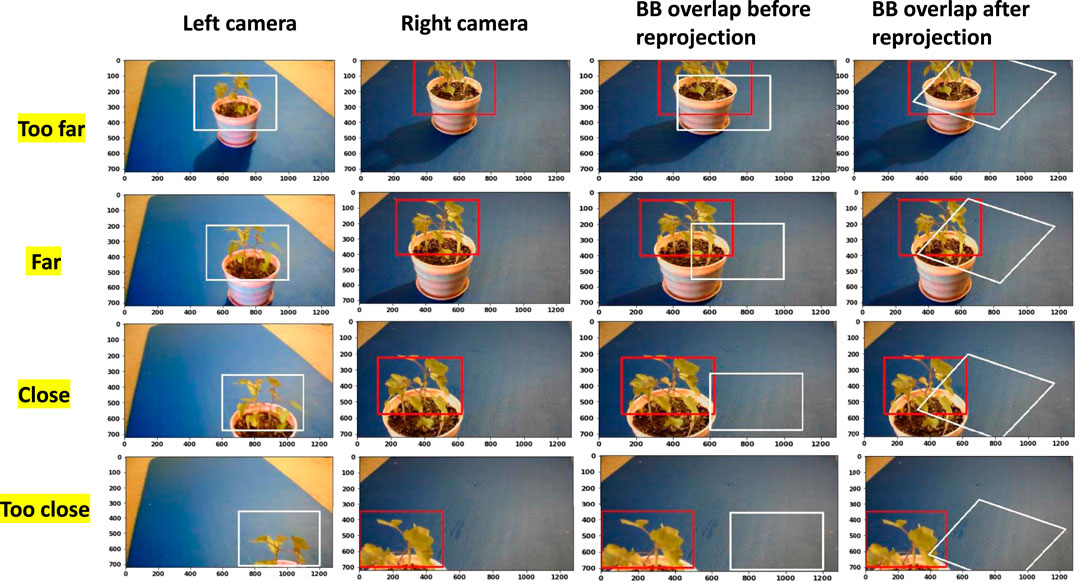
FIGURE 5. How BB overlap changes when weed is placed at different distances from the camera. “too far,” “far,” “close,” and “too close” represent the distance of the weed from the camera. “After reprojection” shows the BB overlap when the left camera image is reprojected using H. BB size, width: 500 pixels; height: 350 pixels.
Figure 6 shows how the IOU value changes when weed distance (position of BB) changes. As an example, for “close” position and for perfect detection, the IOU overlap between two cameras should be 15%. The IOU overlap after reprojection is always bigger than that before reprojection. As we move farther, the difference between two different systems reduces. In the actual scenario, a CNN detector will create a BB based on the size or shape of the object, and they will be different based on the scenario. But for this study, we have kept the BB size constant (BB width: 500 pixels, height: 350 pixels). But in future, different BB sizes could be considered, and the IOU value should be calculated for a range of BB sizes.
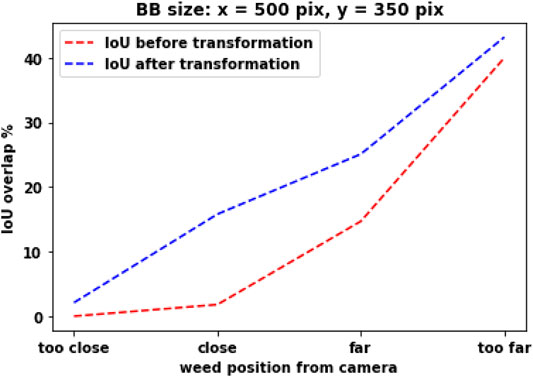
FIGURE 6. IOU overlap value with respect to distance from the camera. (A) BB size, width: 500 pixels; height: 350 pixels. (B) BB size, width: 450 pixels; height: 300 pixels.
5 Fuzzy Logic–Based Fusion
Fuzzy logic was invented by Lotfi Zadeh (Zadeh, 1965) by combining crisp logic and set theory. In reality, many concepts are better defined by human words than by mathematics. Zadeh tried to capture that link between human language and mathematics. Zadeh used fuzzy sets to capture that relationship. If there is uncertainty about membership data regarding those data belonging to a particular set, fuzzy sets are used to define those data to a partial set: as an example, if fuzzy sets are used to define the bounding box position of weed that can be defined as “too close,” “close,” “far,” or “too far”; and for confidence of fused bounding box as “low,” “ok,” and “high.” The membership degree quantifies the level of how those data belong to that set. As an example, in the case of bounding box distance from the camera center:
where
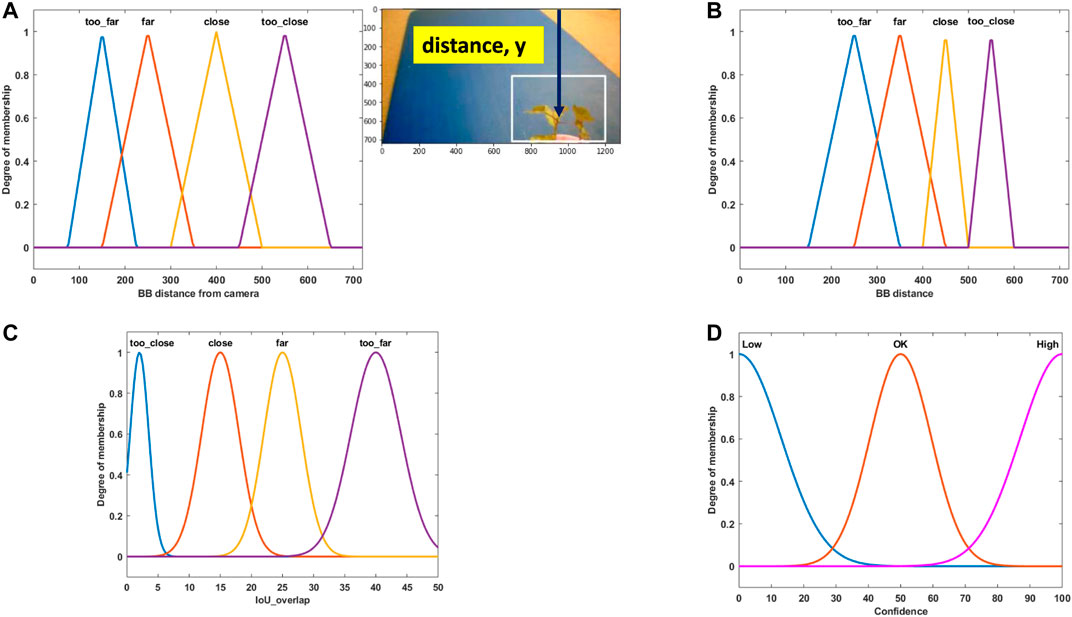
FIGURE 7. (A) Fuzzy set for the weed bounding box distance in camera view for the right camera [Input]. (B) Fuzzy set for the weed bounding box distance in camera view for the left camera [Input]. (C) Fuzzy set for bounding box overlap between the left and right cameras [Input]. (D) Fuzzy set for fusion confidence [Output].
Membership function expresses various degrees of strength between the elements in fuzzy set. If likelihood is higher that an element belongs to a certain set, then the membership strength is also higher. Membership strength of zero means that the element does not belong to that set, and membership strength of one means that the element definitely belongs to that set. In this study, fuzzy sets are used to define the distance of bounding box, IOU overlap, and confidence in the bounding box position.
The membership function design is based on a combination of our personal experience and the knowledge we gained from the camera setup testing. In Figures 7A,B, the membership function for the right and left camera bounding box position is presented, respectively. Weed is placed at four different distances in front of the camera, as shown in Figure 5. Fuzzy names are selected based on their position (“too far,” “close,” etc.). Triangular membership functions are selected to represent their strength. As an example, in Figure 7A, for “too far” position, the BB distance has a maximum degree of membership (one) at position 150 (pixel), which means when weed is placed at “too far” position and the best BB is generated by the CNN detector, the BB y-position center (vertical distance) is found at 150 pixels from the top position of the camera view. In Figure 7C, the membership function for IOU overlap is presented. It is derived from Figure 6. As an example, for the “close” position, the IOU overlap value from Figure 6 is 15%, which means that when weed is placed at the “close” position and BB is created from the CNN detector, for perfect detection (best possible fit of BB over the weed), the IOU overlap value will be 15%. The overlap value will be different if it is not a perfect detection at this position. The Gaussian membership function is used to represent this. Figure 7D shows the confidence membership function. If the BB distance and IOU overlap value perfectly match, then they will have “high” confidence and based on their deviation from perfect condition and the fuzzy rule set, they can be “ok” or “low.”
5.1 Fuzzy Steps and Rule Set
The overall fuzzy system with inputs, rule evaluations, and defuzzification (output) is presented in Figure 8. Following steps are followed for the application of fuzzy analysis:
1. Identify inputs with their ranges and name them: In this study, the subsets for weed distance and IOU overlap are too close, close, far, and too far.
2. Identify output with their ranges and name them: In this study, the subsets for confidence are low, ok, and high.
3. Create a degree of the fuzzy membership function for inputs and outputs: Figure 7 shows this.
4. Construct the rule base for the system based on expert judgment: The rules creates a linguistic relationship between the input variables and the output. In a fuzzy “IF..THEN” rule, the IF part is the premise and the THEN part is the output based on premise. The rules can be combined with logical “OR” or logical “AND.” Here, the three input variables are the following: RightCam BB (right camera BB distance), LeftCam BB (left camera BB distance, and IOU overlap, and the output variable is Confidence. The generic conditional statement used in this study is as follows:
where
5. Defuzzification: A centroid defuzzification method is used in this research (Ross et al., 2004).
6 Results
Three scenarios are created and tested to check the performance of the fuzzy system. In all the following scenarios, we are assuming that the CNN detector is detecting the weed with 100% accuracy inside the BB, the whole weed plant is visible from both cameras, and there is no occlusion.
6.1 Scenario 1: High Confidence
Weed at position “too close” is chosen to test the performance of the system. Figure 9 shows all the steps of the fuzzy confidence score measurement system. For “high confidence” situation, the CNN detector detects the weed correctly. The BB covers the whole weed for both cameras, and the weed is usually at the center of the BB. As three inputs, we measure the vertical center distance of the BB for both the cameras and the IOU overlap score. All three inputs goes into the fuzzy rule set. For a specific position of the weed in the 3D world, if the weed is detected by both cameras correctly, then they should have a specific IOU overlap value. As a result, all these inputs trigger the fuzzy rule four (
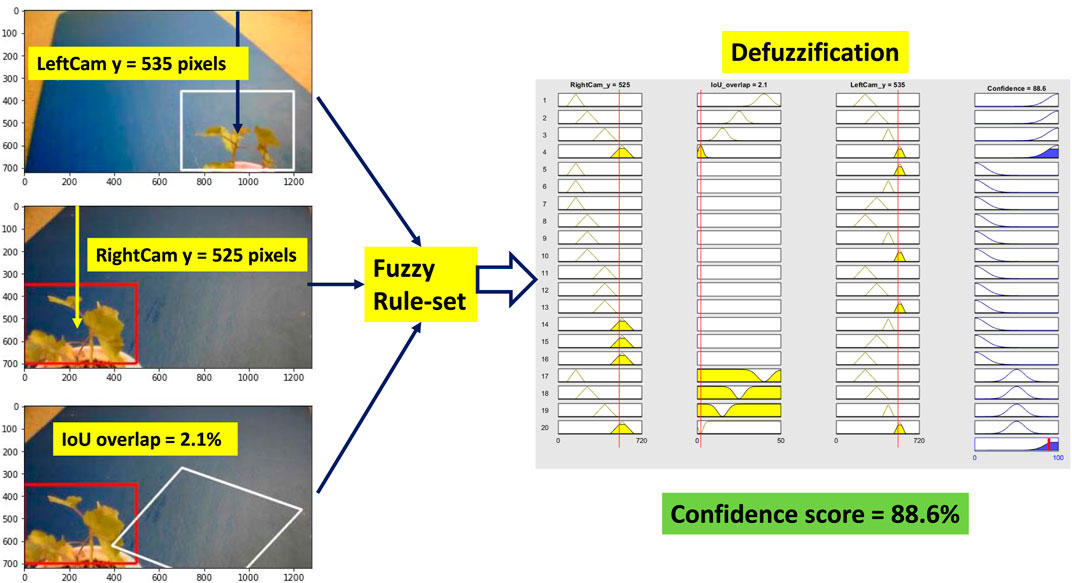
FIGURE 9. Fuzzy confidence score measurement (high confidence). Left-hand side images show the position of detected BB and IoU overlap. Then the position value of the BB and IoU overlap goes into the fuzzy rules defined in Table 3. After the defuzzification step, we receive the confidence score of the detection.
6.2 Scenario 2: OK Confidence
Weed at position “too close” is chosen to test the performance of the system. Figure 10 shows all the steps of the fuzzy confidence score measurement system for “ok confidence” situation. Here, the right camera detects the weed correctly, but the left camera detection is partially correct and detecting the weed at a slightly left position than the actual position. However, the BB center vertical distance for both right and left cameras is correct and comparable to “high confidence” situation. But because the left camera is detecting at a partially correct position, this deviates the IOU overlap value and triggers rule 20 (
6.3 Scenario 3: Low Confidence
Weed at position “too close” is chosen to test the performance of the system. Figure 11 shows all the steps of the fuzzy confidence score measurement system for “low confidence” situation. Here, the right camera detects the weed correctly, but the left camera detection is less than partially correct and detecting the weed at a higher position than the actual position. As a result, the BB center vertical distance is not comparable with the “high confidence” situation. This triggers rule 15 (
One limitation of this fuzzy confidence measurement system is this inherently assumes one of the camera detection is correct. But if both of them are incorrect, then this system may produce a less than ideal confidence score. There are two ways to tackle this limitation. First, for video input, we can incorporate a tracking algorithm for each BB. If a BB position deviates more than a threshold value or more than the previous position, and does not follow a trend, then we can either discard that frame or discard that BB from the fuzzy system to produce better results. Second, we can incorporate more than two cameras into the system. Then we can calculate the evidence distance (in this case BB position) for each camera and then discard or give lower weight to the BB which deviates from usual norm. If we incorporate these into the fuzzy system, then the system becomes more complex and loses the inherent advantage of a fuzzy system which is easy to interpret. If more than two cameras are used, then it is recommended to use uneven number of cameras ((2n+1) numbers of cameras, where
7 Conclusion
In this research, we developed and used a fuzzy logic–based fusion algorithm to calculate the confidence score of the BB position and IOU overlap obtained from a multi-camera–based CNN object detector. First, a CNN-based object detector was used to detect weed at multiple positions in front of the multi-camera setup. Then a projective transformation was used to project one camera’s image onto another camera’s image plane. Then we calculated the IOU overlap value at each of the different positions of the weed for perfect detection. When detecting an object using multiple cameras, the position of the BB on the camera image plane may appear in different places based on the detection accuracy and the position of the cameras. But in 3D space, the object is at the exact same position for all cameras. As a result, a relationship can be established between the IOU overlap value of the BBs and the position of the BBs on a camera image plane. If the BB position or the IOU overlap value deviates from the ideal condition, then that would indicate a less than perfect detection. We generated a fuzzy rule set using this relationship between the BB position of each camera and IOU overlap value. The proposed fuzzy system was tested for three different scenarios, which are ideal detection (high confidence), less than ideal detection (ok confidence), and wrong detection (low confidence). The confidence score of the proposed fuzzy system for three different scenarios proved the hypothesis regarding a relationship between IOU overlap and BB position and offered a more robust overall multi-camera–based object detection system.
Data Availability Statement
The raw data supporting the conclusions of this article will be made available by the authors, without undue reservation.
Author Contributions
MK: conceptualization ideas, methodology, software, validation, and writing—original draft. MA: writing—review and editing, visualization, supervision, and validation. SA: writing—review and editing, supervision, and project administration.
Conflict of Interest
The authors declare that the research was conducted in the absence of any commercial or financial relationships that could be construed as a potential conflict of interest.
References
Bazargani, H., Bilaniuk, O., and Laganière, R. (2018). A Fast and Robust Homography Scheme for Real-Time Planar Target Detection. J. Real-time Image Proc. 15, 739–758. doi:10.1007/s11554-015-0508-4
Chen, W., Xu, T., Liu, J., Wang, M., and Zhao, D. (2019). Picking Robot Visual Servo Control Based on Modified Fuzzy Neural Network Sliding Mode Algorithms. Electronics 8, 605. doi:10.3390/electronics8060605
Fischler, M. A., and Bolles, R. C. (1981). Random Sample Consensus. Commun. ACM 24, 381–395. doi:10.1145/358669.358692
Girshick, R., Donahue, J., Darrell, T., and Malik, J. (2014). Rich Feature Hierarchies for Accurate Object Detection and Semantic Segmentation. In Proceedings of the IEEE Conference on Computer Vision and Pattern Recognition, Columbus, OH, June 23–28, 2014 (IEEE), 580–587.
Hartley, R., and Zisserman, A. (2003). Multiple View Geometry in Computer Vision. Cambridge, United Kingdom: Cambridge University Press.
He, K., Zhang, X., Ren, S., and Sun, J. (2015). Spatial Pyramid Pooling in Deep Convolutional Networks for Visual Recognition. IEEE Trans. Pattern Anal. Mach. Intell. 37, 1904–1916. doi:10.1109/tpami.2015.2389824
Hosseini, H., Xiao, B., Jaiswal, M., and Poovendran, R. (2017). “On the Limitation of Convolutional Neural Networks in Recognizing Negative Images,” in 2017 16th IEEE International Conference on Machine Learning and Applications (ICMLA), Cancun, Mexico, December 18–21, 2017 (IEEE), 352–358.
Inui, K., Kaneko, S. i., and Igarashi, S. (2003). Robust Line Fitting Using Lmeds Clustering. Syst. Comp. Jpn. 34, 92–100. doi:10.1002/scj.1225
Kaehler, A., and Bradski, G. (2016). Learning OpenCV 3: Computer Vision in C++ with the OpenCV Library. Newton, MA: O’Reilly Media, Inc.
Karpathy, A., Toderici, G., Shetty, S., Leung, T., Sukthankar, R., and Fei-Fei, L. (2014). “Large-scale Video Classification with Convolutional Neural Networks,” in Proceedings of the IEEE Conference on Computer Vision and Pattern Recognition, Columbus, OH, June 23–28, 2014 (IEEE), 1725–1732.
Kolhe, S., Raj Kamal, R., Saini, H. S., and Gupta, G. K. (2011). An Intelligent Multimedia Interface for Fuzzy-Logic Based Inference in Crops. Expert Syst. Appl. 38, 14592–14601. doi:10.1016/j.eswa.2011.05.023
Lin, T.-Y., Goyal, P., Girshick, R., He, K., and Dollár, P. (2017). “Focal Loss for Dense Object Detection,” in Proceedings of the IEEE international conference on computer vision, Venice, Italy, October, 22–29, 2980–2988.
Liu, W., Anguelov, D., Erhan, D., Szegedy, C., Reed, S., Fu, C.-Y., et al. (2016). “Ssd: Single Shot Multibox Detector,” in European Conference on Computer Vision, Amsterdam, The Netherlands, October 8–16, 2016 (Springer), 21–37. doi:10.1007/978-3-319-46448-0_2
López, E. M., García, M., Schuhmacher, M., and Domingo, J. L. (2008). A Fuzzy Expert System for Soil Characterization. Environ. Int. 34, 950–958. doi:10.1016/j.envint.2008.02.005
Mamdani, E. H. (1974). Application of Fuzzy Algorithms for Control of Simple Dynamic Plant. Proc. Inst. Electr. Eng. UK 121, 1585–1588. doi:10.1049/piee.1974.0328
Meyer, G. E., Camargo Neto, J., Jones, D. D., and Hindman, T. W. (2004). Intensified Fuzzy Clusters for Classifying Plant, Soil, and Residue Regions of Interest from Color Images. Comput. Electron. Agric. 42, 161–180. doi:10.1016/j.compag.2003.08.002
Mohanty, S. P., Hughes, D. P., and Salathé, M. (2016). Using Deep Learning for Image-Based Plant Disease Detection. Front. Plant Sci. 7, 1419. doi:10.3389/fpls.2016.01419
Moosavi-Dezfooli, S.-M., Fawzi, A., and Frossard, P. (2016). “Deepfool: a Simple and Accurate Method to Fool Deep Neural Networks,” in Proceedings of the IEEE Conference On Computer Vision and Pattern Recognition, Las Vegas, NV, June 27–30, 2574–2582.
Papageorgiou, E. I., Markinos, A. T., and Gemtos, T. A. (2011). Fuzzy Cognitive Map Based Approach for Predicting Yield in Cotton Crop Production as a Basis for Decision Support System in Precision Agriculture Application. Appl. Soft Comput. 11, 3643–3657. doi:10.1016/j.asoc.2011.01.036
Redmon, J., Divvala, S., Girshick, R., and Farhadi, A. (2016). You Only Look once: Unified, Real-Time Object Detection. In Proceedings of the IEEE Conference on Computer Vision and Pattern Recognition, Las Vegas, NV, June 27–30, 779–788.
Romeo, J., Pajares, G., Montalvo, M., Guerrero, J. M., Guijarro, M., and de la Cruz, J. M. (2013). A New Expert System for Greenness Identification in Agricultural Images. Expert Syst. Appl. 40, 2275–2286. doi:10.1016/j.eswa.2012.10.033
Roy, P., Ghosh, S., Bhattacharya, S., and Pal, U. (2018). Effects of Degradations on Deep Neural Network Architectures. Available at: arXiv:1807.10108 (Accessed July 26, 2018).
Russakovsky, O., Deng, J., Su, H., Krause, J., Satheesh, S., Ma, S., et al. (2015). Imagenet Large Scale Visual Recognition Challenge. Int. J. Comput. Vis. 115, 211–252. doi:10.1007/s11263-015-0816-y
Simonyan, K., and Zisserman, A. (2014). Very Deep Convolutional Networks for Large-Scale Image Recognition. Available at: arXiv:1409.1556 (Accessed September 4, 2014).
Sujaritha, M., Annadurai, S., Satheeshkumar, J., Kowshik Sharan, S., and Mahesh, L. (2017). Weed Detecting Robot in Sugarcane Fields Using Fuzzy Real Time Classifier. Comput. Electron. Agric. 134, 160–171. doi:10.1016/j.compag.2017.01.008
Vougioukas, S. G. (2019). Agricultural Robotics. Annu. Rev. Control. Robot. Auton. Syst. 2, 365–392. doi:10.1146/annurev-control-053018-023617
Wang, A., Zhang, W., and Wei, X. (2019). A Review on Weed Detection Using Ground-Based Machine Vision and Image Processing Techniques. Comput. Electron. Agric. 158, 226–240. doi:10.1016/j.compag.2019.02.005
Keywords: object detection, multi-camera, confidence score, fuzzy logic, sensor fusion
Citation: Khan MN, Al Hasan M and Anwar S (2021) Improving the Robustness of Object Detection Through a Multi-Camera–Based Fusion Algorithm Using Fuzzy Logic. Front. Artif. Intell. 4:638951. doi: 10.3389/frai.2021.638951
Received: 07 December 2020; Accepted: 28 April 2021;
Published: 26 May 2021.
Edited by:
Cesar Isaza, Polytechnic University of Querétaro, MexicoReviewed by:
Jonny Paul Zavala De Paz, Polytechnic University of Querétaro, MexicoFrancisco Antonio Castillo, Polytechnic University of Querétaro, Mexico
Cristian Felipe Ramirez Gutierrez, Polytechnic University of Querétaro, Mexico
Copyright © 2021 Khan, Al Hasan and Anwar. This is an open-access article distributed under the terms of the Creative Commons Attribution License (CC BY). The use, distribution or reproduction in other forums is permitted, provided the original author(s) and the copyright owner(s) are credited and that the original publication in this journal is cited, in accordance with accepted academic practice. No use, distribution or reproduction is permitted which does not comply with these terms.
*Correspondence: Md Nazmuzzaman Khan, bWRraGFuQGl1LmVkdQ==
 Md Nazmuzzaman Khan
Md Nazmuzzaman Khan Mohammad Al Hasan2
Mohammad Al Hasan2